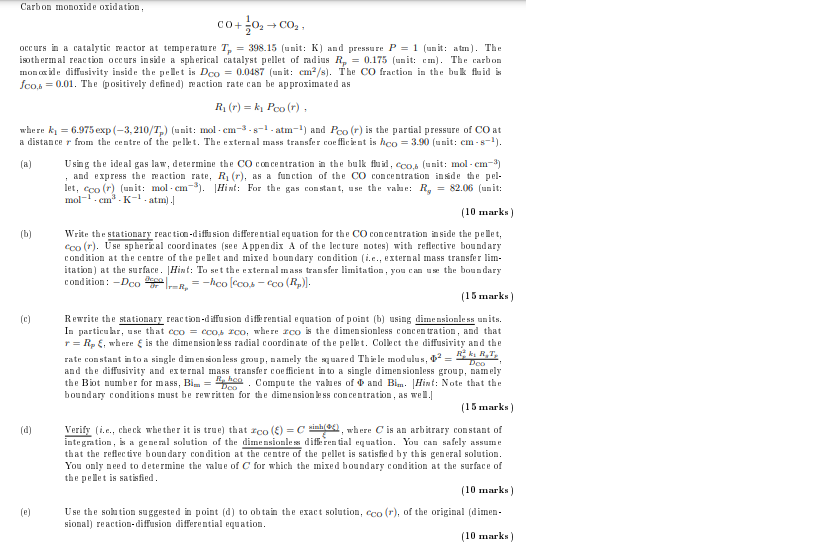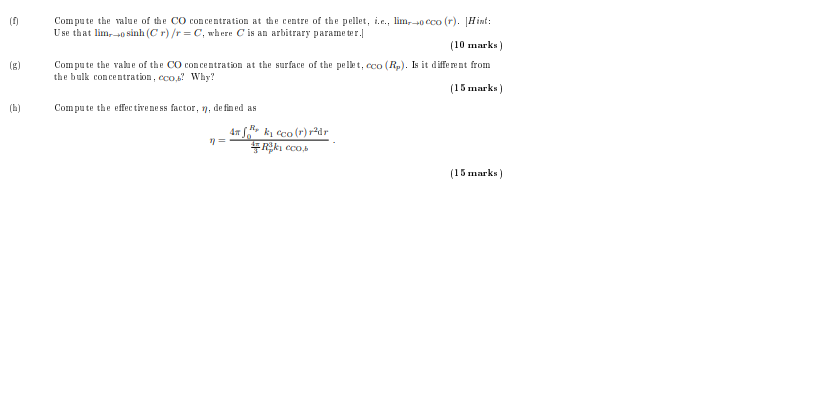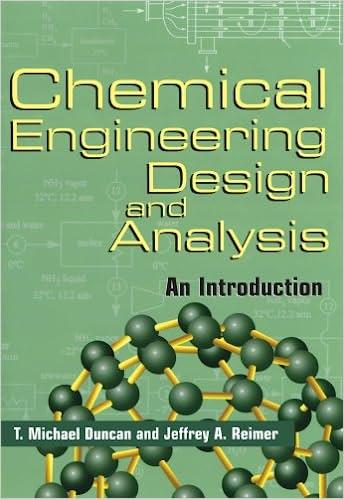

Carbon monoxide oxidation, CO+21O2CO2, occurs in a catalytic reactor at temperature Tp=398.15 (unit: K ) and pressure P=1 (unit: atm). The isothermal reaction occurs inside a spherical catalyst pellet of madis Rp=0.175 (unit: cm ). The carbon monaxide diffusivity inside the pellet is DCO=0.0487 (unit: cm2/s ). The CO fraction in the bulk flesid is fCO,b=0.01. The (positively defined) reaction rate can be approximated as R1(r)=k1PCO(r), where k1=6.975exp(3,210/Tp) (unit: mol cm3s1atm1 ) and PCO(r) is the partial pressure of CO at a distance r from the centre of the pellet. The exteraal mass transfer coefficient is hCO=3.90 (unit: cms1 ). (a) Using the ideal gas law, determine the CO concentration in the bulk fluid, cCO,b (unit: molcocm3 ) , and express the reaction rate, R1(r), as a function of the CO concentration inside the pellet, cCO(r) (unit: mol cm3 ). |Hint: For the gas constant, use the vabe: Ry=82.06 (unit: mol1cm3K1 atmi). (10 marks) (b) Write thestationary reac tion-diffision differential equation for the CO concentration in side the pellet, cCO(r). Use spherical coordinates (see Appendix A of the lecture notes) with reflective boundary condition at the centre of the pellet and mixed boundary condition (i.e., external mass transfer limitation ) at the surface. |Hint: To set the exteralmass transfer limitation, you can usa the boundary condition: DCOrcCor=Rp=hCO[cCO,bcCO(Rp)]. (15 marks) (c) Rewrite the stationary reaction-diffusion differential equation of point (b) using dimensionless units. In particular, use that cCO=ccCO,bxCO, where xCO is the dimensionless concentration, and that r=RP, where is the dimensionless radial coordinate of the pelkt. Colket the diffusivity and the rate constant in to a single dimension less group, a amely the squared Thirle modulus, 2=DRs2k1R2T, and the diffusivity and external mass transfer coefficient in to a single dimes sionless group, namely the Biot number for mass, Bim=DRehco. Compute the values of and Bim. |Hint: Note that the boundary conditions must be rewritten for the dimensionless concentration, as well.| (15 marks) (d) Verify (i.e., check whe ther it is true) that xCO()=Cximh(), where C is an arbitrary constant of integration, is a general solution of the dimensionles differen tial equation. You can safely assume that the reflective boundary condition at the centre of the pellet is satisfied by this general solution. You only aeed to determine the value of C for which the mixed boundary condition at the surface of the pellet is satisfied. (10 marks) (e) Use the solution suggested in point (d) to obtain the exact solution, cCo(r), of the original (dimensional) reaction-diffusion differential equation. (10 marks) f) Compute the value of the CO concentration at the centre of the pellet, i.e., limr0cCO(r).H int: Use that limr0sinh(Cr)/r=C, where C is as arbitrary parame ter. (10 marks) g) Compute the value of the CO concentration at the sarface of the pelle, cCo (Rp). Is it differet from the bulk concentration, cco,b? Why? (15 marks) b) Compute the effec tiveness factor, , de fined as =34Rp3k1cCO,b40Rpk1cCO(r)r2dr Carbon monoxide oxidation, CO+21O2CO2, occurs in a catalytic reactor at temperature Tp=398.15 (unit: K ) and pressure P=1 (unit: atm). The isothermal reaction occurs inside a spherical catalyst pellet of madis Rp=0.175 (unit: cm ). The carbon monaxide diffusivity inside the pellet is DCO=0.0487 (unit: cm2/s ). The CO fraction in the bulk flesid is fCO,b=0.01. The (positively defined) reaction rate can be approximated as R1(r)=k1PCO(r), where k1=6.975exp(3,210/Tp) (unit: mol cm3s1atm1 ) and PCO(r) is the partial pressure of CO at a distance r from the centre of the pellet. The exteraal mass transfer coefficient is hCO=3.90 (unit: cms1 ). (a) Using the ideal gas law, determine the CO concentration in the bulk fluid, cCO,b (unit: molcocm3 ) , and express the reaction rate, R1(r), as a function of the CO concentration inside the pellet, cCO(r) (unit: mol cm3 ). |Hint: For the gas constant, use the vabe: Ry=82.06 (unit: mol1cm3K1 atmi). (10 marks) (b) Write thestationary reac tion-diffision differential equation for the CO concentration in side the pellet, cCO(r). Use spherical coordinates (see Appendix A of the lecture notes) with reflective boundary condition at the centre of the pellet and mixed boundary condition (i.e., external mass transfer limitation ) at the surface. |Hint: To set the exteralmass transfer limitation, you can usa the boundary condition: DCOrcCor=Rp=hCO[cCO,bcCO(Rp)]. (15 marks) (c) Rewrite the stationary reaction-diffusion differential equation of point (b) using dimensionless units. In particular, use that cCO=ccCO,bxCO, where xCO is the dimensionless concentration, and that r=RP, where is the dimensionless radial coordinate of the pelkt. Colket the diffusivity and the rate constant in to a single dimension less group, a amely the squared Thirle modulus, 2=DRs2k1R2T, and the diffusivity and external mass transfer coefficient in to a single dimes sionless group, namely the Biot number for mass, Bim=DRehco. Compute the values of and Bim. |Hint: Note that the boundary conditions must be rewritten for the dimensionless concentration, as well.| (15 marks) (d) Verify (i.e., check whe ther it is true) that xCO()=Cximh(), where C is an arbitrary constant of integration, is a general solution of the dimensionles differen tial equation. You can safely assume that the reflective boundary condition at the centre of the pellet is satisfied by this general solution. You only aeed to determine the value of C for which the mixed boundary condition at the surface of the pellet is satisfied. (10 marks) (e) Use the solution suggested in point (d) to obtain the exact solution, cCo(r), of the original (dimensional) reaction-diffusion differential equation. (10 marks) f) Compute the value of the CO concentration at the centre of the pellet, i.e., limr0cCO(r).H int: Use that limr0sinh(Cr)/r=C, where C is as arbitrary parame ter. (10 marks) g) Compute the value of the CO concentration at the sarface of the pelle, cCo (Rp). Is it differet from the bulk concentration, cco,b? Why? (15 marks) b) Compute the effec tiveness factor, , de fined as =34Rp3k1cCO,b40Rpk1cCO(r)r2dr








